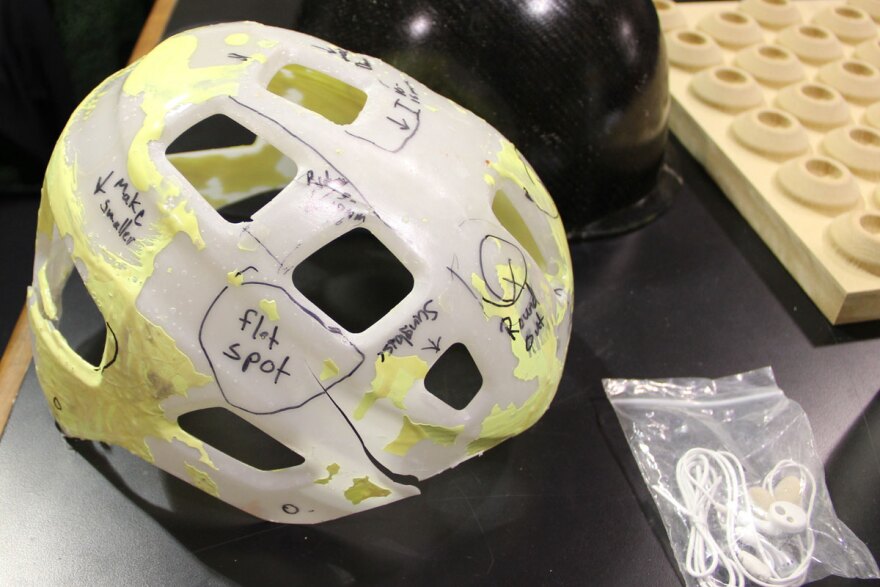Safety glasses securely in place, Clint Bickmore is hoisting a large metal plug into the air. His business partner, Nathan Saam helpfully points out that "you might want to step back a little bit." Beneath the affectionately named "spike of doom" sits a primitive-looking G.I. Joe-style helmet, dull black in color.
"So we accelerate this spike to almost 15 miles an hour and we drop it on top of the shell to see if we get penetration in the helmet," Saam said.
The spike plunges down, and with a clunk, hits the top of the shell. Three large cracks spiral out of the plastic, but it's not broken. In fact, it's barely dented. If it was like most helmets, it would have shattered or at least suffered a big indentation with a small fracture pattern, said Saam.
This destruction has a point. Saam and Bickmore are trying to build a better bike helmet.
"I would find myself swimming in the quagmire," he said.
In Colorado, though, Saam found fellow makers and a shared space, Longmont’s TinkerMill, with the tools he needed to test out his helmet. It's built with a proprietary composite plastic made to withstand and distribute impact.
Later, Fort Collins came calling and the Colorado State University graduate enrolled in the university’s Venture Accelerator, a program tailored to help him take an idea and transform it into a business.
Like many good ideas, when Saam explains his, it seems obvious. Bicycle technology has changed rapidly in recent years. Cyclists go harder and faster than ever. Helmet technology, in contrast, "was designed in the 1980s. That's crazy."

Mimicking natural protective systems -- picture how a shell and white protects an egg yolk, or your skull and fluid protects your brain -- Umbo Helmets are super hard on the outside, with foam acting like the interior fluid.
The goal is to prevent traumatic brain injuries. Saam has personal experience with this.
"From the day I was born, if I could huck my Big Wheel off stuff, I would."
He joined the Marine Corps after high school, then after a tour in Iraq eventually joined the Navy as well.
"I've always liked to push the limits and biking is no different."
He started downhill biking with friends in Colorado. After waking up confused in the emergency room after two traumatic brain injuries, he decided it was time for something different.
The company is focusing on bike helmets first, because that's Saam's passion. Long term, though, he sees markets in hockey, rock climbing, motor sports and maybe even football, Saam said, recalling the long term brain damage suffered by NFL players.
All along the way, Saam's company was shaped by the opportunities available where he lived. At the TinkerMill in Longmont he met Bickmore, a materials scientist who became his Chief Technology Officer. Bickmore signed on after covertly watching Saam hammer on a helmet he had just made.
Saam was "whacking on this helmet shell with a hammer. A big hammer," said Bickmore. "And I'm going, ‘I wouldn't be doing that to something I just made.’"

When Bickmore saw the helmet had "no damage," he was shocked.
"I said, ‘I don't know what you're doing here, but here's my card and I'm here if you want help,’" Bickmore said.
To move from the construction side of the business at the TinkerMill to the business side of his enterprise, Saam turned to the Venture Accelerator program at CSU. There, he honed his idea into something that could be a profitable business, he said.
Christine Chin, who directs the Venture Accelerator at CSU, said that's the point.
"It's a great program for students that have an idea and want to move it from an idea to a program that they can launch."
Now at the Rocky Mountain Innosphere, a nonprofit incubator that is funded in part by the university, Saam is looking to move his helmets into production. Like other startups born of CSU student ideas, there he'll get help securing machinery to produce the helmets, suppliers for his materials. More importantly, he'll also get connected with funding.
It's been a long journey from his garage, Saam said.
"I first started this company, I thought, ‘oh yeah I'm going to start it with $20,000 and people are going to start handing me money after that and it's going to take off overnight.’"
Now he knows better. Even if it takes longer and costs more, though, the support, training and networks Saam found in Northern Colorado give him a pretty good chance of success, whether it's with this project or the next one he dreams up.







